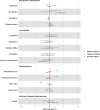The circadian rest-activity pattern predicts cognitive decline among mild-moderate Alzheimer's disease patients
- PMID: 34563258
- PMCID: PMC8466995
- DOI: 10.1186/s13195-021-00903-7
The circadian rest-activity pattern predicts cognitive decline among mild-moderate Alzheimer's disease patients
Abstract
Background: Alterations in circadian rhythms are present in the presymptomatic stage of Alzheimer's disease (AD), possibly contributing to its pathogenesis. However, it is unknown whether such alterations are associated with worse outcomes once individuals are diagnosed with symptomatic disease. We aimed to evaluate the association between the circadian rest-activity pattern and AD-related features in patients with mild-moderate AD.
Methods: We assessed the circadian rest-activity pattern of consecutive patients with mild-moderate AD through actigraphy for 14 days. Cerebrospinal fluid was obtained to determine the levels of important pathological markers including amyloid-beta protein (Aβ42), phosphorylated tau (P-tau), total tau (T-tau), and neurofilament light (NF-L). Neuropsychological evaluation was conducted at the beginning of the study and after 12 months of follow-up. Linear regression models were performed considering the global population and Aβ42+ patients only.
Results: The cohort included 100 patients with mild-moderate AD. The median age [p25;p75] was 76.0 [73.0;80.0] years and 63.0% were female. Older age (effect size [SE] of 0.324 [0.096]; p = 0.001) and male sex (0.780 [0.193]; p = 0.001) were associated with increased fragmentation and decreased synchronization of the rhythm, respectively. After adjusting for age, sex, and season of the year, increased levels of T-tau (effect size [95% CI] of 0.343 [0.139 to 0.547]; p = 0.001) and NF-L (0.444 [0.212 to 0.676]; p = 0.001) were associated with a higher amplitude of the rest-activity rhythm. Increased fragmentation of the rhythm at baseline was associated with greater cognitive decline after one year of follow-up independent of age, sex, T-tau/Aβ42 ratio, educational level, and season of the year (- 0.715 [- 1.272 to - 0.157]; p = 0.013). Similar findings were obtained considering only the Aβ42+ patients.
Conclusions: Our results suggest a potential role of the circadian rest-activity pattern in predicting the cognitive decline of patients with mild-moderate AD. Further studies are warranted to confirm these findings and to elucidate whether there is causality among the observed associations.
Keywords: Alzheimer’s disease; Circadian rest-activity pattern; Cognitive decline; Intradaily variability; Neurofilament light.
© 2021. The Author(s).
Conflict of interest statement
The authors declare that they have no competing interests.
Figures


References
-
- Nichols E, Szoeke CEI, Vollset SE, Abbasi N, Abd-Allah F, Abdela J, Aichour MTE, Akinyemi RO, Alahdab F, Asgedom SW, Awasthi A, Barker-Collo SL, Baune BT, Béjot Y, Belachew AB, Bennett DA, Biadgo B, Bijani A, Bin Sayeed MS, Brayne C, Carpenter DO, Carvalho F, Catalá-López F, Cerin E, Choi JYJ, Dang AK, Degefa MG, Djalalinia S, Dubey M, Duken EE, Edvardsson D, Endres M, Eskandarieh S, Faro A, Farzadfar F, Fereshtehnejad SM, Fernandes E, Filip I, Fischer F, Gebre AK, Geremew D, Ghasemi-Kasman M, Gnedovskaya EV, Gupta R, Hachinski V, Hagos TB, Hamidi S, Hankey GJ, Haro JM, Hay SI, Irvani SSN, Jha RP, Jonas JB, Kalani R, Karch A, Kasaeian A, Khader YS, Khalil IA, Khan EA, Khanna T, Khoja TAM, Khubchandani J, Kisa A, Kissimova-Skarbek K, Kivimäki M, Koyanagi A, Krohn KJ, Logroscino G, Lorkowski S, Majdan M, Malekzadeh R, März W, Massano J, Mengistu G, Meretoja A, Mohammadi M, Mohammadi-Khanaposhtani M, Mokdad AH, Mondello S, Moradi G, Nagel G, Naghavi M, Naik G, Nguyen LH, Nguyen TH, Nirayo YL, Nixon MR, Ofori-Asenso R, Ogbo FA, Olagunju AT, Owolabi MO, Panda-Jonas S, Passos VMA, Pereira DM, Pinilla-Monsalve GD, Piradov MA, Pond CD, Poustchi H, Qorbani M, Radfar A, Reiner RC, Jr, Robinson SR, Roshandel G, Rostami A, Russ TC, Sachdev PS, Safari H, Safiri S, Sahathevan R, Salimi Y, Satpathy M, Sawhney M, Saylan M, Sepanlou SG, Shafieesabet A, Shaikh MA, Sahraian MA, Shigematsu M, Shiri R, Shiue I, Silva JP, Smith M, Sobhani S, Stein DJ, Tabarés-Seisdedos R, Tovani-Palone MR, Tran BX, Tran TT, Tsegay AT, Ullah I, Venketasubramanian N, Vlassov V, Wang YP, Weiss J, Westerman R, Wijeratne T, Wyper GMA, Yano Y, Yimer EM, Yonemoto N, Yousefifard M, Zaidi Z, Zare Z, Vos T, Feigin VL, Murray CJL. Global, regional, and national burden of Alzheimer’s disease and other dementias, 1990–2016: a systematic analysis for the Global Burden of Disease Study 2016. Lancet Neurol. 2019;18(1):88–106. doi: 10.1016/S1474-4422(18)30403-4. - DOI - PMC - PubMed
-
- United Nations. World Population Ageing 2019 Highlights. World Popul. Ageing 2019 Highlights. 2019. 10.18356/9df3caed-en.
-
- Alzheimer’s disease facts and figures. Alzheimer’s Dement. 2020. 10.1002/alz.12068.
Publication types
MeSH terms
Substances
LinkOut - more resources
Full Text Sources
Medical
Research Materials

